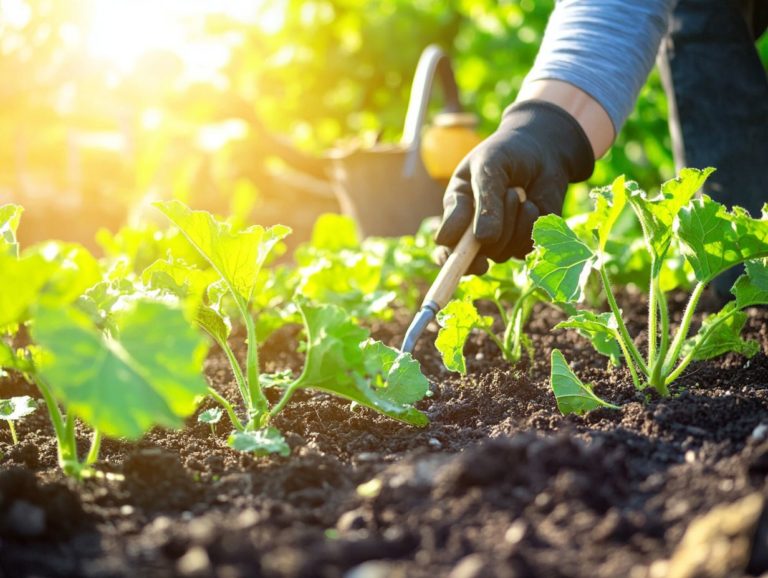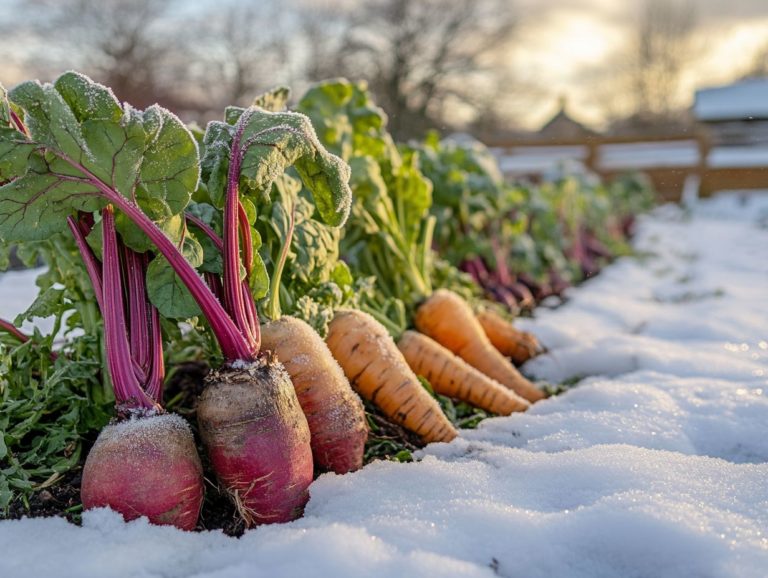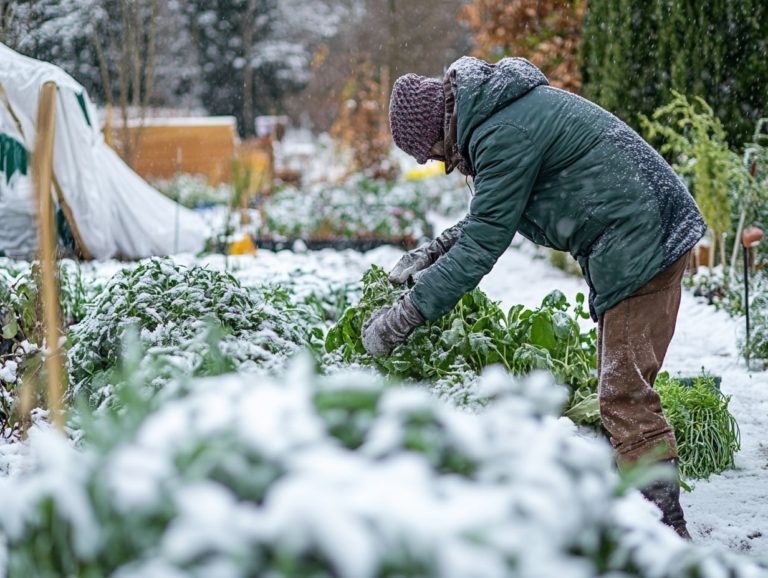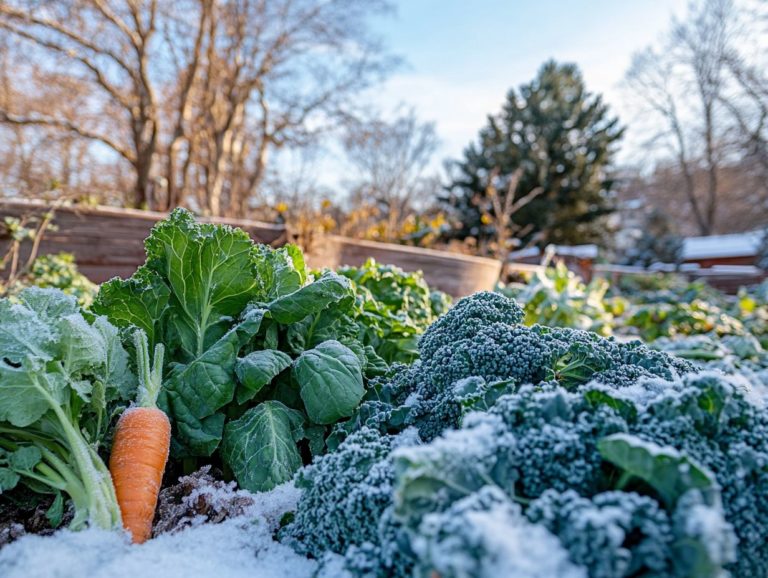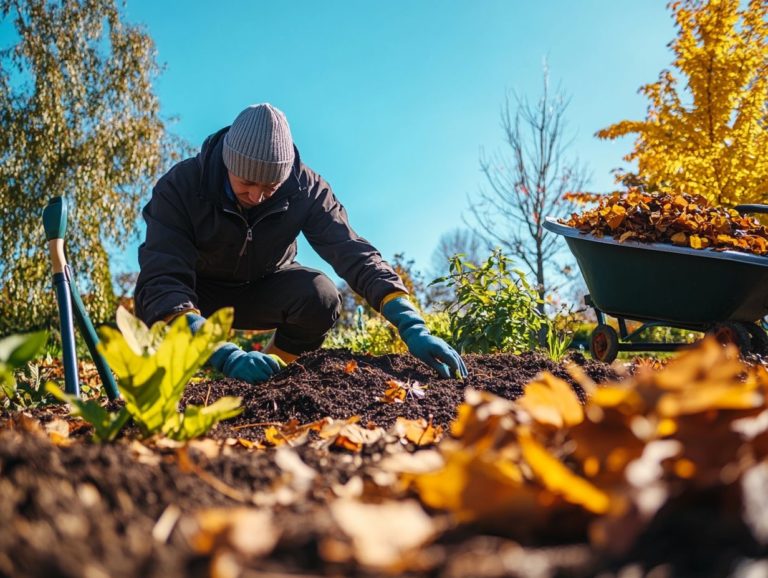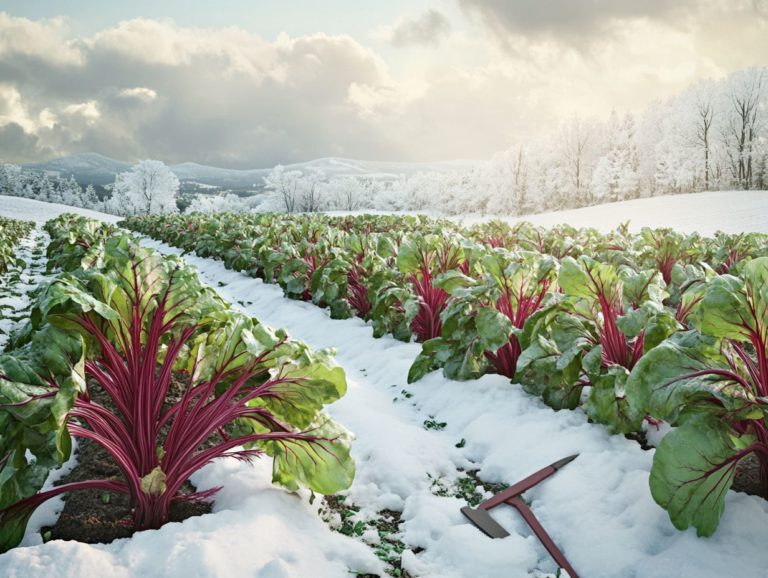Winter Crop Care: What to Do After Harvest
As the harvest season draws to a close, it is the perfect moment for you to redirect your attention to the vital tasks that will help safeguard the fruits of your labor throughout the winter and beyond. This guide offers you a thorough post-harvest checklist, including everything from effective storage techniques to methods for preserving your crops for future enjoyment.
You’ll also find essential steps for readying your garden for winter and strategies for protecting your crops against harsh weather and pesky pests. With the right approach, you can keep your garden flourishing year-round!
Contents
- Key Takeaways:
- Your Essential Post-Harvest Checklist for Success!
- Storing Crops for the Winter
- Preserving Crops for Future Use
- Preparing the Garden for Winter
- Winter Crop Maintenance
- Frequently Asked Questions
- What should I do with leftover plant material after harvest?
- How should I prepare my soil for the winter after harvest?
- Should I leave my fields fallow during the winter?
- How do I protect my fields from winter weeds?
- Do I need to fertilize my fields after harvest?
- Is there anything else I should do to care for my fields during the winter and improve my vegetable gardening?
Key Takeaways:
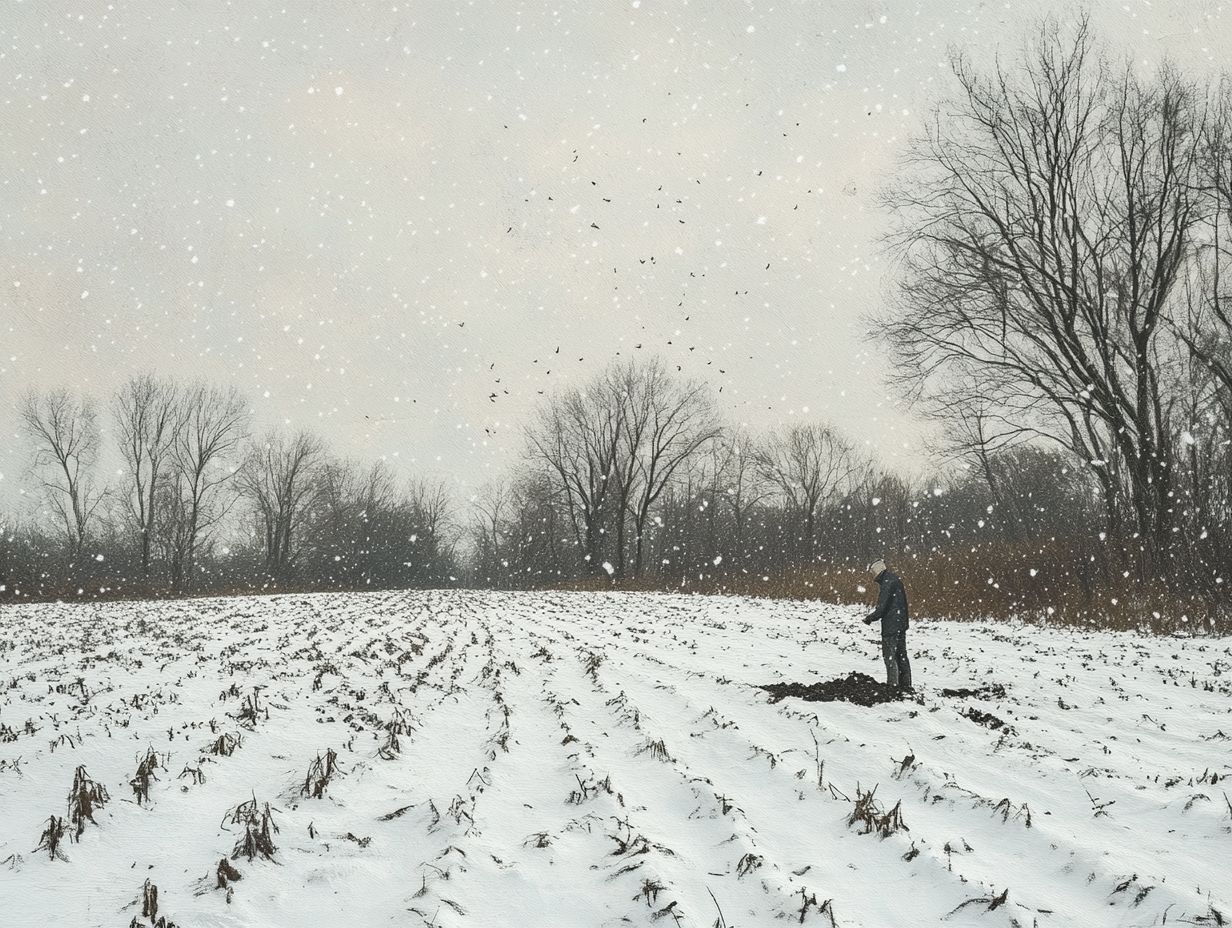
- Proper post-harvest care is crucial for ensuring the quality and longevity of your crops.
- Learn the best storage techniques to keep your winter crops fresh and safe from spoiling.
- Preserving crops through canning, freezing, or dehydrating allows for future use and minimizes waste.
Your Essential Post-Harvest Checklist for Success!
A comprehensive post-harvest checklist is crucial for your successful winter gardening. It ensures that every task related to vegetable gardening and the management of your homegrown produce is systematically tackled. This involves assessing the health of your seasonal crops and planning your future planting schedules.
Maximizing the efficiency of your garden tools is also important. Soil testing and understanding how compost helps your garden can greatly improve your gardening practices, leading to a more bountiful harvest in the upcoming seasons.
Important Tasks to Complete
During the post-harvest period, it’s essential to assess the overall health of your winter vegetable gardening efforts and ensure that your homegrown produce is stored correctly. Beyond these key tasks, you can also refer to winter crop care tips to tidy up your garden beds by removing any lingering debris and weeds that might attract pests or diseases.
Preparing for future seasonal crops means enriching your soil with organic matter, such as compost, which enhances nutrient levels and improves soil structure. Efficient gardening techniques like mulching will aid in retaining moisture and regulating soil temperature through the colder months.
Finally, conducting a brief inventory of your gardening supplies and tools will ensure you re ready for the upcoming planting season, setting the stage for a more fruitful garden.
Storing Crops for the Winter
Storing crops for the winter is essential for preserving the freshness of your harvest. This includes techniques that extend the longevity of root vegetables, such as carrots and beets, alongside leafy greens like spinach and lettuce.
By employing proper methods, you can ensure that vegetables like garlic stay fresh throughout the colder months. This maximizes the fruits of your gardening efforts and promotes efficient gardening practices, allowing you to enjoy your harvest long after the growing season has ended. Additionally, a vibrant garden can help combat seasonal affective disorder, a type of depression that can occur during winter due to lack of sunlight.
Proper Storage Techniques

Proper storage techniques for winter crops are essential for preserving the quality of fresh vegetables. You can use methods such as cold storage (keeping vegetables in a cool place), root cellaring (storing vegetables underground), and even simple shelving to extend the lifespan of your produce.
For instance, leafy greens flourish in a moisture-controlled environment, while root vegetables like carrots and potatoes thrive in dark, cool conditions. Adding a layer of compost to the soil boosts nutrient availability and fosters beneficial microorganisms that help maintain the integrity of these vegetables.
By embracing these diverse storage practices, you’ll significantly extend the freshness of your yields, ensuring you savor the rewards of your hard work long after the harvest!
Preserving Crops for Future Use
Preserving crops for future use is an invaluable practice for any gardener, especially when it involves your own homegrown produce. This endeavor includes several effective methods that ensure nutrients remain intact and flavors stay robust, allowing you to savor the fruits of your labor long after the harvest season has passed.
Get ready for a bountiful winter! Start your winter preparations now to enjoy a thriving garden!
Methods for Long-Term Preservation
Methods for preserving fresh vegetables for the long haul include techniques like freezing, canning, and fermenting. These methods allow you to relish homegrown produce even during the off-seasons.
Each of these methods brings its own set of advantages, helping you retain not just the nutrients of your vegetables but also their delightful natural flavors. For example, freezing quickly lowers the temperature of fresh produce, halting enzyme activity that can lead to spoilage. This technique effectively locks in vitamins and minerals while offering a convenient option that’s perfect for whipping up quick meals.
Canning, in contrast, employs high heat to create a vacuum seal that protects vegetables from bacteria and significantly extends their shelf life. Fermenting encourages beneficial bacteria to flourish, adding a tangy flavor while enhancing nutrient absorption. This means your body can use the nutrients more effectively.
Understanding these methods helps you enjoy the vibrant taste of seasonally harvested vegetables all year round!
Preparing the Garden for Winter
Preparing your garden for winter encompasses a series of vital tasks that will enhance both the longevity and productivity of your gardening endeavors in the upcoming season.
Start by cleaning up garden beds. Consider planting cover crops like clover or rye to enrich the soil. These proactive measures not only shield your crops from winter’s harsh conditions but also establish a solid foundation for more efficient gardening and vibrant growth when the warm months return.
Cleaning Up and Prepping for Next Season
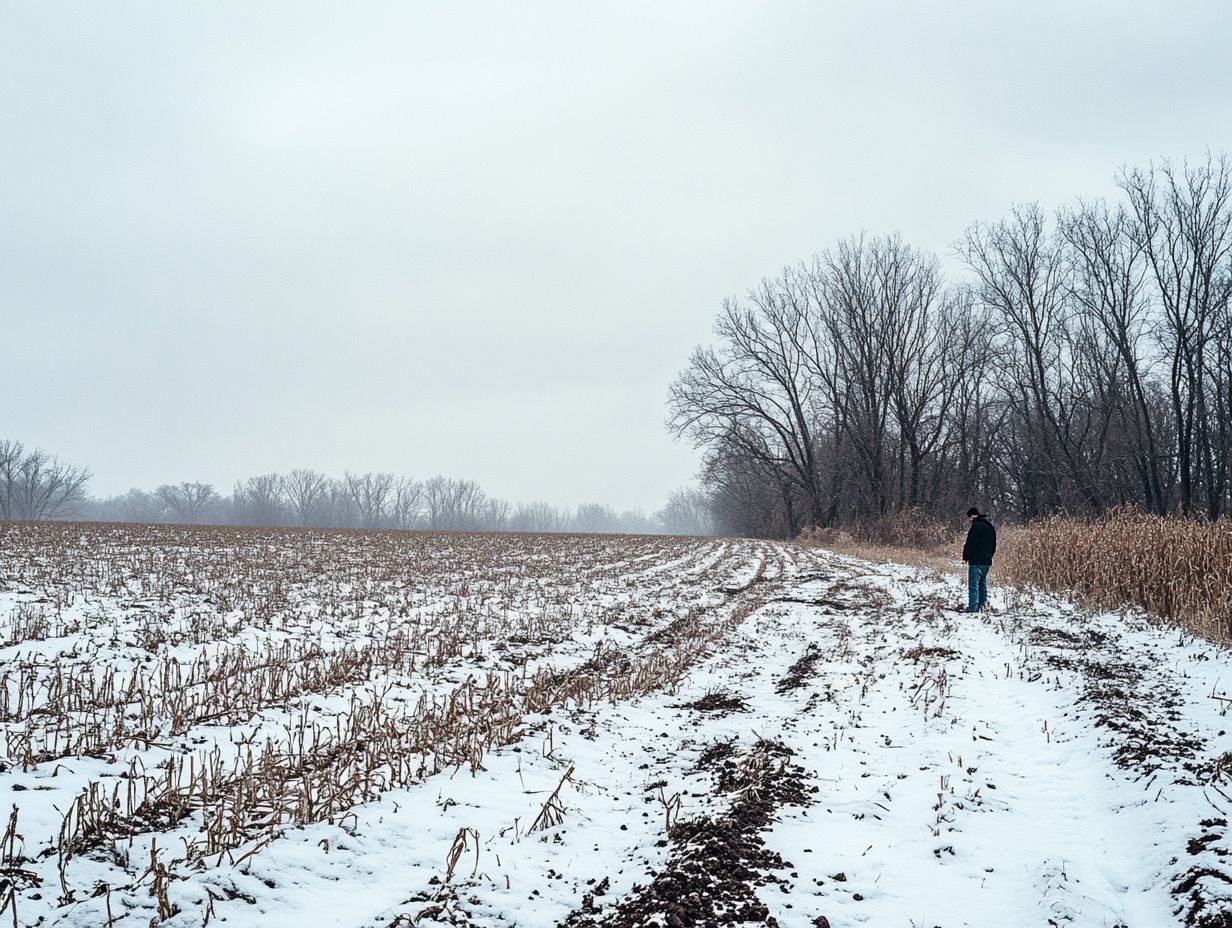
Cleaning up and preparing your garden for the upcoming season is an essential winter gardening task that lays the groundwork for a thriving environment when spring arrives.
This process entails several practical steps, such as:
- Clearing away debris that could attract pests and diseases,
- Managing compost to enrich your soil with organic matter.
By thoughtfully removing fallen leaves and dead plants, you can avert potential problems and create a clean slate for new growth. When you prepare your garden beds for winter by adding mulch, you’re not just insulating the soil; you’re also enhancing moisture retention.
Embracing these best practices facilitates a smooth transition, setting the stage for a vibrant and productive garden once the warmer months return! Get ready for a bountiful harvest!
Winter Crop Maintenance
Winter crop maintenance is crucial for shielding your plants from the chill and pesky pests. This ensures that your winter gardening endeavors yield fresh vegetables all season long. By employing effective strategies, including indoor gardening techniques, you not only protect your crops but also reap health benefits, allowing you to savor the delights of homegrown produce, even in the heart of winter.
Protecting Crops from Cold and Pests
Protecting your crops from cold and pests is crucial in winter gardening, especially when it comes to leafy greens and other delicate vegetables that are susceptible to harsh conditions.
Utilizing techniques like row covers made from lightweight fabric can create a microclimate for your tender plants. This shields them from icy winds while still allowing sunlight to filter through. By employing organic mulch around the base of these crops, you not only help to regulate soil temperature but also suppress weed growth and retain moisture effectively.
Implementing companion planting can serve as a natural pest deterrent, promoting a healthier garden ecosystem. Exploring these diverse protective measures enhances the resilience of your winter crops and contributes to a more sustainable gardening practice, ensuring that your harvest flourishes even in challenging weather conditions.
Frequently Asked Questions
What should I do with leftover plant material after harvest?

It’s important to remove all plant debris from the field after harvest to prevent the spread of disease and pests. You can either compost the material or dispose of it off-site.
How should I prepare my soil for the winter after harvest?
The most important step is to till or plow the field. This incorporates leftover plant material and loosens the soil.
You can also add improvements like compost or manure to boost soil health!
Should I leave my fields fallow during the winter?
It is usually recommended to plant a cover crop during the winter. This protects the soil from erosion and adds nutrients.
Some common winter cover crops include rye, vetch, and clover. Want to keep your soil healthy? Plant a cover crop!
How do I protect my fields from winter weeds?
Weeds can still grow in winter, so take action! Use herbicides or manual weeding to prevent them from competing with your crops.
This is especially crucial if you plan to plant a cover crop.
Do I need to fertilize my fields after harvest?
Before applying fertilizers, do a soil test. Your soil may already have enough nutrients.
If needed, apply a balanced fertilizer to ensure your fields have adequate nutrients for winter and the upcoming growing season!
Is there anything else I should do to care for my fields during the winter and improve my vegetable gardening?
Also, monitor your fields for erosion. Take steps to prevent it with mulch or cover crops that have strong root systems!
Start your winter preparation today for a more fruitful harvest next year!

